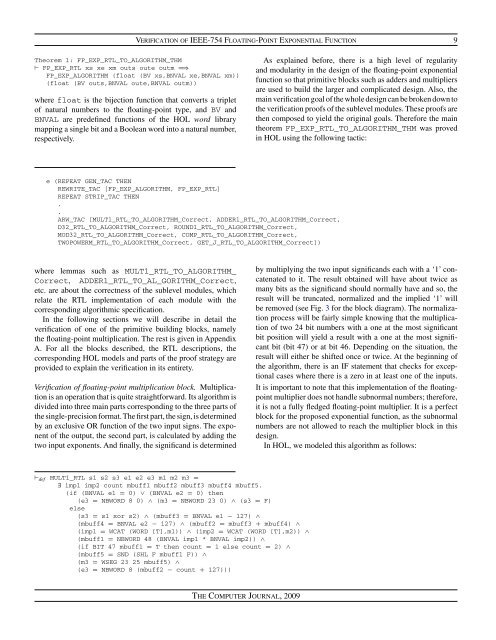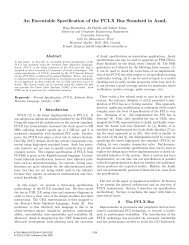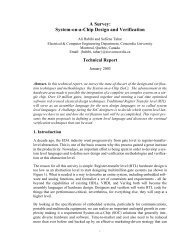Verifying a Synthesized Implementation of IEEE-754 Floating-Point ...
Verifying a Synthesized Implementation of IEEE-754 Floating-Point ...
Verifying a Synthesized Implementation of IEEE-754 Floating-Point ...
- No tags were found...
You also want an ePaper? Increase the reach of your titles
YUMPU automatically turns print PDFs into web optimized ePapers that Google loves.
Verification <strong>of</strong> <strong>IEEE</strong>-<strong>754</strong> <strong>Floating</strong>-<strong>Point</strong> Exponential Function 9Theorem 1: FP_EXP_RTL_TO_ALGORITHM_THM⊢ FP_EXP_RTL xs xe xm outs oute outm =⇒FP_EXP_ALGORITHM (float (BV xs,BNVAL xe,BNVAL xm))(float (BV outs,BNVAL oute,BNVAL outm))where float is the bijection function that converts a triplet<strong>of</strong> natural numbers to the floating-point type, and BV andBNVAL are predefined functions <strong>of</strong> the HOL word librarymapping a single bit and a Boolean word into a natural number,respectively.As explained before, there is a high level <strong>of</strong> regularityand modularity in the design <strong>of</strong> the floating-point exponentialfunction so that primitive blocks such as adders and multipliersare used to build the larger and complicated design. Also, themain verification goal <strong>of</strong> the whole design can be broken down tothe verification pro<strong>of</strong>s <strong>of</strong> the sublevel modules. These pro<strong>of</strong>s arethen composed to yield the original goals. Therefore the maintheorem FP_EXP_RTL_TO_ALGORITHM_THM was provedin HOL using the following tactic:e (REPEAT GEN_TAC THENREWRITE_TAC [FP_EXP_ALGORITHM, FP_EXP_RTL]REPEAT STRIP_TAC THEN..ARW_TAC [MULT1_RTL_TO_ALGORITHM_Correct, ADDER1_RTL_TO_ALGORITHM_Correct,D32_RTL_TO_ALGORITHM_Correct, ROUND1_RTL_TO_ALGORITHM_Correct,MOD32_RTL_TO_ALGORITHM_Correct, COMP_RTL_TO_ALGORITHM_Correct,TWOPOWERM_RTL_TO_ALGORITHM_Correct, GET_J_RTL_TO_ALGORITHM_Correct])where lemmas such as MULT1_RTL_TO_ALGORITHM_Correct, ADDER1_RTL_TO_AL_GORITHM_Correct,etc. are about the correctness <strong>of</strong> the sublevel modules, whichrelate the RTL implementation <strong>of</strong> each module with thecorresponding algorithmic specification.In the following sections we will describe in detail theverification <strong>of</strong> one <strong>of</strong> the primitive building blocks, namelythe floating-point multiplication. The rest is given in AppendixA. For all the blocks described, the RTL descriptions, thecorresponding HOL models and parts <strong>of</strong> the pro<strong>of</strong> strategy areprovided to explain the verification in its entirety.Verification <strong>of</strong> floating-point multiplication block. Multiplicationis an operation that is quite straightforward. Its algorithm isdivided into three main parts corresponding to the three parts <strong>of</strong>the single-precision format.The first part, the sign, is determinedby an exclusive OR function <strong>of</strong> the two input signs. The exponent<strong>of</strong> the output, the second part, is calculated by adding thetwo input exponents. And finally, the significand is determinedby multiplying the two input significands each with a ‘1’ concatenatedto it. The result obtained will have about twice asmany bits as the significand should normally have and so, theresult will be truncated, normalized and the implied ‘1’ willbe removed (see Fig. 3 for the block diagram). The normalizationprocess will be fairly simple knowing that the multiplication<strong>of</strong> two 24 bit numbers with a one at the most significantbit position will yield a result with a one at the most significantbit (bit 47) or at bit 46. Depending on the situation, theresult will either be shifted once or twice. At the beginning <strong>of</strong>the algorithm, there is an IF statement that checks for exceptionalcases where there is a zero in at least one <strong>of</strong> the inputs.It is important to note that this implementation <strong>of</strong> the floatingpointmultiplier does not handle subnormal numbers; therefore,it is not a fully fledged floating-point multiplier. It is a perfectblock for the proposed exponential function, as the subnormalnumbers are not allowed to reach the multiplier block in thisdesign.In HOL, we modeled this algorithm as follows:⊢ def MULT1_RTL s1 s2 s3 e1 e2 e3 m1 m2 m3 =∃ imp1 imp2 count mbuff1 mbuff2 mbuff3 mbuff4 mbuff5.(if (BNVAL e1 = 0) ∨ (BNVAL e2 = 0) then(e3 = NBWORD 8 0) ∧ (m3 = NBWORD 23 0) ∧ (s3 = F)else(s3 = s1 xor s2) ∧ (mbuff3 = BNVAL e1 − 127) ∧(mbuff4 = BNVAL e2 − 127) ∧ (mbuff2 = mbuff3 + mbuff4) ∧(imp1 = WCAT (WORD [T],m1)) ∧ (imp2 = WCAT (WORD [T],m2)) ∧(mbuff1 = NBWORD 48 (BNVAL imp1 * BNVAL imp2)) ∧(if BIT 47 mbuff1 = T then count = 1 else count = 2) ∧(mbuff5 = SND (SHL F mbuff1 F)) ∧(m3 = WSEG 23 25 mbuff5) ∧(e3 = NBWORD 8 (mbuff2 − count + 127)))The Computer Journal, 2009





